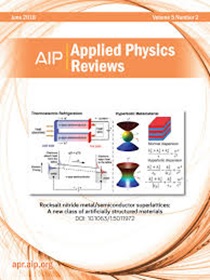Extraordinary three-state terahertz transient conductivity switching at room temperature in multi-band nickelates for high-speed communication
IF 11.6
1区 物理与天体物理
Q1 PHYSICS, APPLIED
引用次数: 0
Abstract
The realization of multiple electronic states on ultrafast sub-picosecond timescales can be leveraged to develop energy-efficient terahertz (THz) photonic devices. Such explorations are pursued in the framework of femtosecond optical excitation with THz probes wherein either negative or positive photoconductivity manifests in metallic and insulating states, respectively. Co-existence of both states is highly desired but rarely observed. Here, a strategy is devised exploiting crystalline transport anisotropy and hetero-epitaxy in a multi-band nickelate to demonstrate switching of the positive to the negative sign of photoconductivity on a sub-picosecond timescale. This combines with a profound anisotropy of THz photoconductivity in unconventional (111) epitaxial films having preferential arrangement of oxygen vacancies along selective crystal axes—a framework that reversibly modulates the anisotropy of negative THz photoconductivity using oxygen content as a control parameter, and corroborated by theoretical calculations. Thus, ultrafast switching between negative, positive, and zero photoconductive states in timescales of a few picoseconds at room temperature, as demonstrated in this study, holds a remarkable prospect for creating multiple channels of information processing. A proof-of-concept experiment to utilize these photo-controlled states is proposed for a three-state THz communication system, which would transmit a larger volume of information vis-a-vis that of a binary communication system.室温下用于高速通信的多波段镍合金中超常三态太赫兹瞬态电导率开关
在超快亚皮秒时间尺度上实现多电子态可以用来开发节能的太赫兹(THz)光子器件。这种探索是在飞秒光激发的框架下进行的,太赫兹探针在金属和绝缘状态下分别表现为负或正光电导率。两种状态的共存是非常希望的,但很少能实现。在这里,我们设计了一种策略,利用多带镍酸盐中的晶体传输各向异性和异质外延来证明在亚皮秒时间尺度上光电导率的正负转换。这与非常规(111)外延薄膜中具有沿选择性晶体轴优先排列氧空位的太赫兹光电导率的深远各向异性相结合-一个使用氧含量作为控制参数可逆调节负太赫兹光电导率各向异性的框架,并通过理论计算得到证实。因此,在室温下,在几皮秒的时间尺度内,在负、正、零光导状态之间的超快切换,正如本研究所证明的那样,对于创建多个信息处理通道具有显著的前景。提出了一个利用这些光控状态的概念验证实验,用于三态太赫兹通信系统,与二进制通信系统相比,它将传输更大的信息量。
本文章由计算机程序翻译,如有差异,请以英文原文为准。
求助全文
约1分钟内获得全文
求助全文
来源期刊

Applied physics reviews
PHYSICS, APPLIED-
CiteScore
22.50
自引率
2.00%
发文量
113
审稿时长
2 months
期刊介绍:
Applied Physics Reviews (APR) is a journal featuring articles on critical topics in experimental or theoretical research in applied physics and applications of physics to other scientific and engineering branches. The publication includes two main types of articles:
Original Research: These articles report on high-quality, novel research studies that are of significant interest to the applied physics community.
Reviews: Review articles in APR can either be authoritative and comprehensive assessments of established areas of applied physics or short, timely reviews of recent advances in established fields or emerging areas of applied physics.
 求助内容:
求助内容: 应助结果提醒方式:
应助结果提醒方式:


